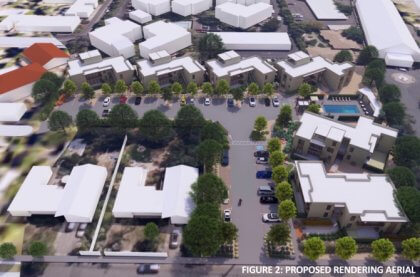2024’s first major housing development application in the City of Sonoma was unanimously approved by the Sonoma Planning Commission at its meeting of May 16th.

This rendering shows the development’s six buildings and the common parking lot shared by the residents. The two structures to the left of the driveway are private homes not part of the project.
254 First Street East, a parcel across the street from Arnold Field on which a succession of unsuccessful proposals have been made over the past three or four years, finally received approval for a fully, multi-family residential development of 31 condos, all but six of which are 850 square feet or less.
Intended to satisfy the City’s hope to provide “missing middle” housing, the development is an effort to provide housing that is more affordable “by design” that will be attractive to first-time home buyers, young professionals and older residents looking to downsize from larger homes.
Proposed by North of the Mission, LLC, a development group comprised of neighbors to the project site, the two-acre parcel will feature six contemporary apartment buildings, a swimming pool and common, open space parking for residents and guests. No commercial use is planned, although the Mixed-Use zoning designation allows it. Past proposals that have failed to garner support have included hotels combined with a much higher number of units, and even an eighty-room residential facility for seniors.
The current proposal was widely supported by residents of the neighborhood, although some concerns were raised about the two-story apartments with private roof decks reducing privacy for some adjacent properties.
Plans for the project include positioning the six buildings on a diagonal axis rather than perpendicular to the lot line, a pattern that existing adjacent condo developments also display. This arrangement, noted architect Carol Marcus, eliminates positioning the sides of buildings perpendicular to the properly line, thereby increasing the sense of open space, allowing light to penetrate the spaces between buildings better, and preventing two-story walls sitting at the edges of the required setbacks.
In order for the project to proceed, the existing buildings on the site, none of which have been deemed historic and requiring preservation, will be demolished. In addition, a lot line adjustment was proposed and approved that will allow emergency vehicle egress through an easement to the north, connecting to Blue Wing Drive.
The design of the project falls under the provisions of Planned Development, a land-use development designation that allows more flexibility in design due to unique parcel configurations but also a higher degree of design sensitivity to environmental and site specific conditions. The large number of mature oak trees at the southern border of the parcel, which adjoin the parking lot of the neighboring Vintage House, will be preserved, for example, as will many other existing trees along the property line.
As to the matter of affordability, 850 square foot units are exempt from the City’s inclusionary requirement, which mandates that 25% of new housing units be designated affordable under the city’s affordable housing program. Instead, the six units larger than 850 square feet means that only two units will be deemed affordable under the city’s regulations. It’s hoped that the smaller units will satisfy the need for more affordable ones, and the commission agreed that there is some uncertainty about the sales prices in a market-driven approach. This is the first project to test the hypothesis that smaller means lower-priced.
In general, multi-family developments with common-area parking, no private garages, and shared walls sell at a lower price than stand-alone, single-family homes.
Kelso Barnett, former Planning Commissioner, City Council member and neighborhood property owner, spoke on behalf of the applicants, explaining that the project proposal only moved forward after conversations with the neighborhood. He expressed confidence that this project, unlike previous proposals, responds appropriately to the City’s hope that developers answer its current housing needs.
The commission obviously was pleased, and after an exhaustive hour-and-a-half examination of all the issues involved, voted unanimously to approve the application.






The First Street East (FSE) project was approved unanimously on 5/16/24, only five days after the Project was noticed. Much of the public never even knew about it. The Project was approved in its entirety, minus a pending Quimby Act parks assessment fee waiver review by the city attorney.
The Project conformed to the letter but not the sense of the city’s 6/21 25% inclusionary ordinance.
FSE takes advantage of a loophole in the 25% inclusionary ordinance. Tested will be an unproven assumption that an exemption for 850 square foot or less units will result in 22 FSE 850 square foot units being “affordable by design” to a “missing middle” cohort who makes 140% -160% of the area median income. This after the a number of the same Planning Commission people said on-record previously that this same size unit can’t be affordable by design in Sonoma.
We’ll have to see what they all sell for and if they go for market rate, and if any “missing middle” people get them. 850 sf is not exactly a family-type unit. More like a retirement unit.
The upshot for the City’s Housing Element is that FSE left six lower-income deed-restricted units unredeemed on the table, burned, gone, in effect traded out for an assumption that the 850 sf units will sell for a lower price. This leaves only one Lower-income housing unit on the east side for the whole 6th cycle Housing Element, and no Lower-income excess capacity units there either. This carving away of lower-income affordability in a tax credit high resource area seems by objective measure to promote class and racial segregation and not be consistent with the Cal state Affirmatively Furthering Fair Housing (AFFH) law.
With FSE, one more lower-income Housing Opportunity site has been lost to a market rate project; this in a city with very few lots able to take projects of any size.
Sonoma has now set a precedent for SDC and Hanna project developers to count “affordable by design” units as OK to count off against lower-income units in the county inclusionary ordinance.